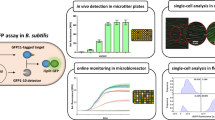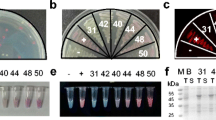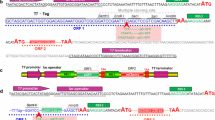Abstract
The expression of heterologous proteins in the cytoplasm of Escherichia coli is often accompanied by limitations resulting in uncontrollable fermentation processes, increased rates of cell lysis, and thus limited yields of target protein. To deal with these problems, reporter tools are required to improve the folding properties of recombinant protein. In this work, the well-known σ32-dependent promoters ibpAB and fxsA were linked in a tandem promoter (ibpfxs), fused with the luciferase reporter gene lucA to allow enhanced monitoring of the formation of misfolded proteins and their aggregates in E. coli cells. Overexpression of MalE31, a folding-defective variant of the maltose-binding protein, and other partially insoluble heterologous proteins showed that the lucA reporter gene was activated in the presence of these misfolded proteins. Contrary to this, the absence of damaged proteins or overexpression of mostly soluble proteins led to a reduced level of luciferase induction. Through performing expression of aggregation-prone proteins, we were able to demonstrate that the ibpfxs::lucA reporter unit is 2.5–4.5 times stronger than the single reporter units ibp::lucA and fxs::lucA. Data of misfolding studies showed that this reporter system provides an adequate tool for in vivo folding studies in E. coli from microtiter up to fermentation scales.





Similar content being viewed by others
References
Betton J, Hofnung M (1996) Folding of a mutant maltose-binding protein of Escherichia coli which forms inclusion bodies. J Biol Chem 271:8046–8052
Bianchi AA, Baneyx F (1999a) Hyperosmotic shock induces the sigma32 and sigmaE stress regulons of Escherichia coli. Mol Microbiol 34:1029–1038
Bianchi AA, Baneyx F (1999b) Stress responses as a tool to detect and characterize the mode of action of antibacterial agents. Appl Environ Microbiol 65:5023–5027
Blaszczak A, Zylicz M, Georgopoulos C, Liberek K (1995) Both ambient temperature and the DnaK chaperone machine modulate the heat shock response in Escherichia coli by regulating the switch between sigma 70 and sigma 32 factors assembled with RNA polymerase. EMBO J 14:5085–5093
Blattner FR, Plunkett G 3rd, Bloch CA, Perna NT, Burland V, Riley M, Collado-Vides J, Glasner JD, Rode CK, Mayhew GF, Gregor J, Davis NW, Kirkpatrick HA, Goeden MA, Rose DJ, Mau B, Shao Y (1997) The complete genome sequence of Escherichia coli K-12. Science 277:1453–1474
Carrio MM, Villaverde A (2003) Role of molecular chaperones in inclusion body formation. FEBS Lett 537:215–521
Chuang SE, Burland V, Plunkett 3rd G, Daniels DL, Blattner FR (1993) Sequence analysis of four new heat-shock genes constituting the hslTS/ibpAB and hslVU operons in Escherichia coli. Gene 134:1–6
Cowing DW, Bardwell JC, Craig EA, Woolford C, Hendrix RW, Gross CA (1985) Consensus sequence for Escherichia coli heat shock gene promoters. Proc Natl Acad Sci USA 82:2679–2683
Crameri A, Whitehorn EA, Tate E, Stemmer WP (1996) Improved green fluorescent protein by molecular evolution using DNA shuffling. Nat Biotechnol 14:315–319
Dehio M, Knorre A, Lanz C, Dehio C (1998) Construction of versatile high-level expression vectors for Bartonella henselae and the use of green fluorescent protein as a new expression marker. Gene 215:223–229
Erickson JW, Vaughn V, Walter WA, Neidhardt CF, Gross CA (1987) Regulation of the promoters and transcripts of rpoH, the Escherichia coli heat shock regulatory gene. Genes Dev 1:419–432
Gamer J, Bujard H, Bukau B (1992) Physical interaction between heat shock proteins DnaK, DnaJ, and GrpE and the bacterial heat shock transcription factor sigma 32. Cell 69:833–842
Gamer J, Multhaup G, Tomoyasu T, McCarty JS, Rüdiger S, Schönfeld HJ, Schirra C, Bujard H, Bukau B (1996) A cycle of binding and release of the DnaK, DnaJ and GrpE chaperones regulates activity of the Escherichia coli heat shock transcription factor sigma32. EMBO J 15:607–617
Grossman AD, Erickson JW, Gross CA (1984) The htpR gene product of E. coli is a sigma factor for heat-shock promoters. Cell 38:383–390
Grossman AD, Straus DB, Walter WA, Gross CA (1987) Sigma 32 synthesis can regulate the synthesis of heat shock proteins in Escherichia coli. Genes Dev 1:179–184
Gumpert J, Hoischen C, Kujau M (2002) Protein expression in L-form bacteria. In: Weiner MP, Lu Q (eds) Gene cloning and expression technologies. BioTechniques Press, Eaton Publishing, Westborough, MA, pp 213–226
Jürgen B, Lin HY, Riemschneider S, Scharf C, Neubauer P, Schmid R, Hecker M, Schweder T (2000) Monitoring of genes that respond to overproduction of an insoluble recombinant protein in Escherichia coli glucose-limited fed-batch fermentations. Biotechnol Bioeng 70:217–224
Kanemori M, Mori H, Yura T (1994) Induction of heat shock proteins by abnormal proteins results from stabilization and not increased synthesis of sigma 32 in Escherichia coli. J Bacteriol 176:5648–5653
Kapust RB, Waugh DS (1999) Escherichia coli maltose-binding protein is uncommonly effective at promoting the solubility of polypeptides to which it is fused. Protein Sci 8:1668–1674
Keseler IM, Collado-Vides J, Gama-Castro S, Ingraham J, Paley S, Paulsen IT, Peralta-Gil M, Karp PD (2005) EcoCyc: a comprehensive database resource for Escherichia coli. Nucleic Acids Res 33:334–337
Kuczyńska-Wiśnik D, Kedzierska S, Matuszewska E, Lund P, Taylor A, Lipinska B, Laskowska E (2002) The Escherichia coli small heat-shock proteins IbpA and IbpB prevent the aggregation of endogenous proteins denatured in vivo during extreme heat shock. Microbiology 148:1757–1765
Landick R, Vaughn V, Lau ET, VanBogelen RA, Erickson JW, Neidhardt FC (1984) Nucleotide sequence of the heat shock regulatory gene of E. coli suggests its protein product may be a transcription factor. Cell 38:175–182
Larsen JE, Gerdes K, Light J, Molin S (1984) Low-copy-number plasmid-cloning vectors amplifiable by derepression of an inserted foreign promoter. Gene 28:45–54
Laskowska E, Wawrzynow A, Taylor A (1996) IbpA and IbpB, the new heat-shock proteins, bind to endogenous Escherichia coli proteins aggregated intracellularly by heat shock. Biochimie 78:117–122
Lesley SA, Graziano J, Cho CY, Knuth MW, Klock HE (2002) Gene expression response to misfolded protein as a screen for soluble recombinant protein. Protein Eng 15:153–160
Liberek K, Georgopoulos C (1993) Autoregulation of the Escherichia coli heat shock response by the DnaK and DnaJ heat shock proteins. Proc Natl Acad Sci USA 90:11019–11023
Liberek K, Galitski TP, Zylicz M, Georgopoulos C (1992) The DnaK chaperone modulates the heat shock response of Escherichia coli by binding to the sigma 32 transcription factor. Proc Natl Acad Sci USA 89:3516–3520
Lissemore JL, Jankowski JT, Thomas CB, Mascotti DP, deHaseth PL (2000) Green fluorescent protein as a quantitative reporter of relative promoter activity in E. coli. Biotechniques 28:82–84, 86, 88–89
Mogk A, Schlieker C, Friedrich KL, Schönfeld HJ, Vierling E, Bukau B (2003) Refolding of substrates bound to small Hsps relies on a disaggregation reaction mediated most efficiently by ClpB/DnaK. J Biol Chem 278:31033–31042
Motohashi K, Watanabe Y, Yohda M, Yoshida M (1999) Heat-inactivated proteins are rescued by the DnaK J-GrpE set and ClpB chaperones. Proc Natl Acad Sci USA 96:7184–7189
Neidhardt FC, VanBogelen RA (1981) Positive regulatory gene for temperature-controlled proteins in Escherichia coli. Biochem Biophys Res Commun 100:894–900
Parsell DA, Sauer RT (1989) Induction of a heat shock-like response by unfolded protein in Escherichia coli: dependence on protein level not protein degradation. Genes Dev 3:1226–1232
Richmond CS, Glasner JD, Mau R, Jin H, Blattner FR (1999) Genome-wide expression profiling in Escherichia coli K-12. Nucleic Acids Res 27:3821–3835
Sachdev D, Chirgwin JM (1998) Solubility of proteins isolated from inclusion bodies is enhanced by fusion to maltose-binding protein or thioredoxin. Protein Expr Purif 12:122–132
Straus DB, Walter WA, Gross CA (1987) The heat shock response of E. coli is regulated by changes in the concentration of sigma 32. Nature 329:348–351
Straus D, Walter W, Gross CA (1990) DnaK, DnaJ, and GrpE heat shock proteins negatively regulate heat shock gene expression by controlling the synthesis and stability of sigma 32. Genes Dev 4:2202–2209
Tatsuta T, Joob DM, Calendar R, Akiyama Y, Ogura T (2000) Evidence for an active role of the DnaK chaperone system in the degradation of sigma(32). FEBS Lett 478:271–275
Thomas JG, Baneyx F (1998) Roles of the Escherichia coli small heat shock proteins IbpA and IbpB in thermal stress management: comparison with ClpA, ClpB, and HtpG in vivo. J Bacteriol 180:5165–5172
Vasina JA, Baneyx F (1996) Recombinant protein expression at low temperatures under the transcriptional control of the major Escherichia coli cold shock promoter cspA. Appl Environ Microbiol 62:1444–1447
Veinger L, Diamant S, Buchner J, Goloubinoff P (1998) The small heat-shock protein IbpB from Escherichia coli stabilizes stress-denatured proteins for subsequent refolding by a multichaperone network. J Biol Chem 273:11032–11037
Waldo GS, Standish BM, Berendzen J, Terwilliger TC (1999) Rapid protein-folding assay using green fluorescent protein. Nat Biotechnol 17:691–695
Wang WF, Margolin W, Molineux IJ (1999) Increased synthesis of an Escherichia coli membrane protein suppresses F exclusion of bacteriophage T7. J Mol Biol 292:501–512
Wigley WC, Stidham RD, Smith NM, Hunt JF, Thomas PJ (2001) Protein solubility and folding monitored in vivo by structural complementation of a genetic marker protein. Nat Biotechnol 19:131–136
Yamamori T, Yura T (1982) Genetic control of heat-shock protein synthesis and its bearing on growth and thermal resistance in Escherichia coli K-12. Proc Natl Acad Sci USA 79:860–864
Zolkiewski M (1999) ClpB cooperates with DnaK, DnaJ, and GrpE in suppressing protein aggregation A novel multi-chaperone system from Escherichia coli. J Biol Chem 274:28083–28086
Acknowledgements
Thanks to Gisela Sudermann for excellent technical support. Special thanks to Giles Johnson and Friedrich Kring for critical reading of the manuscript. This work was funded by Merck KGaA Darmstadt, Germany.
Author information
Authors and Affiliations
Corresponding author
Rights and permissions
About this article
Cite this article
Kraft, M., Knüpfer, U., Wenderoth, R. et al. An online monitoring system based on a synthetic sigma32-dependent tandem promoter for visualization of insoluble proteins in the cytoplasm of Escherichia coli . Appl Microbiol Biotechnol 75, 397–406 (2007). https://doi.org/10.1007/s00253-006-0815-6
Received:
Revised:
Accepted:
Published:
Issue Date:
DOI: https://doi.org/10.1007/s00253-006-0815-6




